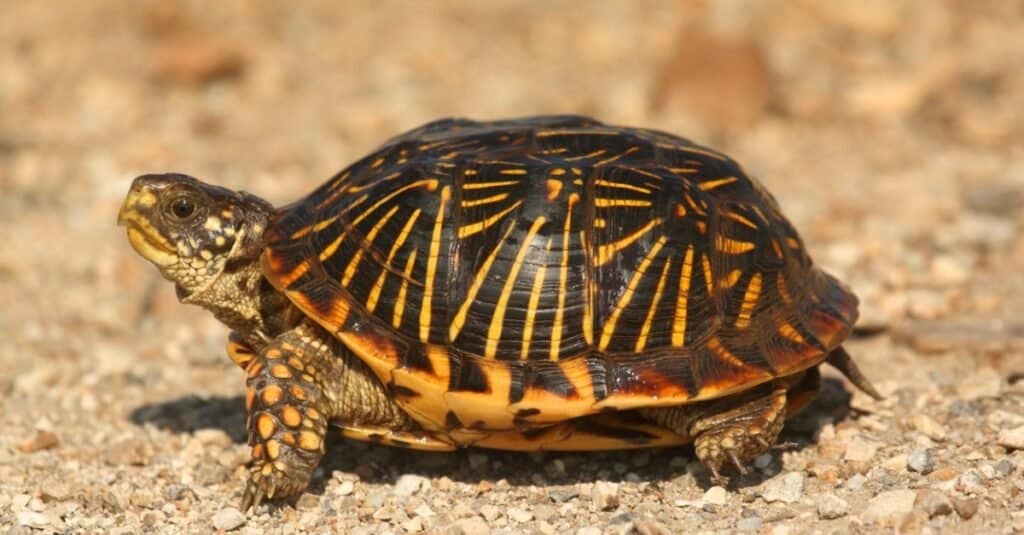Adorably small and compact with an ornately-patterned shell, the humble box turtle is one of North America’s most common and widespread types of turtles! Despite their small size, the many different species of box turtles have an impressive geographic range, covering much of the United States and even parts of Mexico. But did you know box turtles live in Texas, too?
Below, we’ll take a closer look at the Lonestar State’s box turtles, how to identify the different species and subspecies, and what makes these tiny yet remarkably hardy reptiles so unique.
What is a Box Turtle?

Box turtles have somewhat tall, dome-like, hinged shells, often with yellow or orange patterning.
©Jessica Baldwin/Shutterstock.com
Essentially, a box turtle is any one of seven species of small turtles native to North America within the Terrapene genus. Terrapene is one of 10 distinct genera falling under the much larger family of pond turtles, Emydidae. Notably, three box turtle species are also divided into at least two subspecies.
Box turtles are named for their protective, box-like shells. The carapace, or the top portion of the shell, is very tall and dome-like, giving the turtle enough space to completely withdraw its head and limbs inside.
Additionally, part of the box turtle’s plastron–the bottom part of the shell protecting the turtle’s belly–can be flipped upwards like a wide, door-like hinge. This hinged plastron allows the turtle to shut and lock itself inside its shell, giving it further protection from even the most persistent predators. The hinge part of the shell is actually a modified sternum!
Most box turtles average around 4 to 8 inches long and typically have dark brown shells with varying yellow, orange, and white markings. The usual lifespan for a box turtle is around 40 to 60 years, but many individuals live to be more than 100 years old!
Although they are technically pond turtles, box turtles are very hardy and can thrive in a wide range of terrestrial and semi-aquatic habitats. Another trait exemplifying the box turtle’s resilience is its opportunistic, omnivorous diet–it’ll eat about anything it can get into its mouth.
What Kinds of Box Turtles Live in Texas?

Baby box turtles are fragile, but they have very few natural predators as adults.
©Karen Culp/Shutterstock.com
Altogether, the seven species of box turtles dominate most of the United States and parts of Mexico. Some have wide geographic ranges spanning hundreds of miles and multiple states, while others are limited to very small areas.
For most types of box turtles, Texas is a bit too hot and dry for their liking. However, three particular species have managed to make it the perfect home!
Three main species of box turtles (plus their subspecies) can be found in Texas:
- Common box turtle, Terrapene carolina
- Eastern box turtle, Terrapene carolina carolina (subsp.)
- Gulf coast box turtle, Terrapene carolina major (subsp.)
- Western box turtle, Terrapene ornata
- Ornate box turtle, Terrapene ornata ornata (subsp.)
- Desert box turtle, Terrapene ornata luteola (subsp.)
- Three-toed box turtle, Terrapene triunguis
1. Common Box Turtle (Terrapene carolina; 2 subspecies)

The eastern box turtle can be found throughout eastern Texas.
©iStock.com/Alan Doucet
The common box turtle has the widest geographic range of all box turtle species! It can be found throughout much of the eastern half of the United States and is very common in eastern Texas.
As we mentioned earlier, the common box turtle is divided into two subspecies: the eastern and Gulf Coast box turtles. The eastern subspecies’ geographic range is a bit further north, while the Gulf Coast variety likes it a bit warmer and can be found closer to parts of southeast Texas and northern Mexico.
While both subspecies of the common box turtle are very similar in size, they differ in shell/skin color and patterning. The eastern box turtle subspecies typically have a brown shell with irregular yellow markings in the shapes of lines and small splotches. The Gulf coast variety has a much darker, almost grey shell with tiny, more uniform yellow spots.
Additionally, the Gulf Coast box turtle has slightly darker greyish-brown skin. Meanwhile, the eastern box turtle has lighter brown skin with bright yellow spots and splotches.
Notably, the Gulf Coast subspecies is the largest of all box turtle subspecies, usually reaching around 8 inches long. Both subspecies prefer forested habitats close to shallow bodies of water like slow-moving streams and ponds.
2. Western Box Turtle (Terrapene ornata; 2 subspecies)

The western box turtle and its two subspecies can be found in southern Texas.
©iStock.com/SteveByland
The next box turtle species in Texas we’ll cover here is the western box turtle, Terrapene ornata. It’s further divided into two unique subspecies: the ornate and desert box turtles. Both have slightly flatter shells than those of typical box turtles and are also slightly smaller than most other box turtle species and subspecies.
Additionally, the western box turtle and its subspecies prefer hotter, drier habitats than other box turtle varieties. As a result, their geographic range stretches further south into northern Mexico than those of other box turtles. They are skilled burrowers and usually live close to a low-lying body of water like a shallow pond or stream.
True to its name, the ornate box turtle subspecies have an ornately patterned shell. Typically, it is dark brown with varying yellow and orange lines and spots. The desert box turtle variety lacks this colorful patterning and has a more uniformly greyish-brown shell.
3. Three-Toed Box Turtle (Terrapene triunguis)

True to its name, the three-toed box turtle often has three toes on its back feet rather than the usual four.
©iStock.com/irin717
Finally, we come to the three-toed box turtle, which was once considered a subspecies of the aforementioned common box turtle. Today, however, it is considered unique enough to be its own distinct species, and it currently has no subspecies.
This particular box turtle species is mainly native to the south central regions of the United States. Individuals are commonly found throughout eastern Texas and as far east as the Florida Panhandle region!
As its common name suggests, it usually has three toes on its back feet rather than the typical four. However, some turtles have also been found to have four-toed feet in recent years. Its shell has the typical tall, dome-like shape, but it lacks much of the bright yellow patterning common to other box turtle varieties. Both its shell and skin are a drab, mostly uniform brown or tan color.
A quite hardy reptile, the three-toed box turtle has become popular in the pet trade. With optimal care, they can live for more than 50 years!
The photo featured at the top of this post is © Jessica Baldwin/Shutterstock.com
Thank you for reading! Have some feedback for us? Contact the AZ Animals editorial team.






